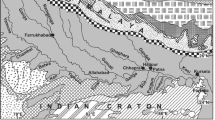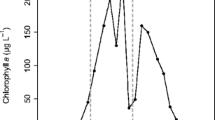Abstract
The spatial and temporal distributions of major elements were investigated in the surface waters and in associated suspended matter at two sites of the upper Loire basin (Orleans and Brehemont) between 1995 and 1998.
According to geochemical and isotopic patterns, the dissolved load appears to result from a process of mixing rainwater inputs, weathering processes of carbonate and silicate bedrock, and agricultural and urban inputs. Natural inputs influence 60% of water chemical composition at both sites. Annual dissolved fluxes were estimated to be 1300 103 t/y at Orleans and 1620 103 t/y at Brehemont. Major elements are transported mainly in the dissolved fraction. After correcting for atmospheric and anthropogenic inputs, the silicate specific export rate was calculated to be 11 t/y/km2 throughout the basin and the carbonate specific export rate to be from 47 t/y/km2 at Orleans to 23 t/y/km2 at Brehemont.
The suspended load appears to result from at least two particle reservoirs: a silicate reservoir and a carbonate reservoir. The silicate reservoir has a detrital origin, mainly during periods of high flow, while the carbonate reservoir has a detrital origin during periods of high flow and an authigenic origin during periods of low flow. Of the total annual flow of suspended matter, this authigenic material represents 16% at Orleans, 25% at Brehemont and 37% in the fluvial part of the estuary. After correcting authigenic inputs, the specific export rate due to mechanical weathering was estimated to be 8 t/y/km2 throughout the Loire basin.
Similar content being viewed by others
References
Agence de l'Eau Loire-Bretagne (1996) Etude du phytoplancton dans la Loire,30 p.
Berner, E. K and Berner, R. A. (1987) The Global Water Cycle, Geochemistry and Environment, Prentice-Hall, Englewood Cliffs, New Jersey, 383 p.
BRGM (1996) Geological Map of France, 1: 1,000,000 scale, 6th edition, Editions BRGM.
Buffle, J. and De Vitre, R. R. (1994) Chemical and Biological Regulation of Aquatic Systems, Lewis publ., 393 p.
Collier, M., Webb, R. H., and Schmidt, J. C. (1996) Dams and rivers: a primer on the downstream effects of dams, USGS, circular 1126, 94 p.
Dojlido, J. R. and Best, G. A. (1993) Chemistry of Water and Water Pollution (ed. Horwood), serie water and wastewater technology, 363 p.
Gaillardet, J., Dupre, B., and Allegre, C. J. (1995) A global geochemical mass budget applied to the Congo basin rivers: erosion rates and continental crust composition, Geochim. Cosmochim. Acta 59, 3469–3485.
Grosbois, C. (1998) Geochemistry of the Loire river waters: natural and anthropogenic inputs-Calculation of erosion rates, unpublished PhD Thesis, University of Tours, 232 p.
Grosbois, C., Négrel, P., Fouillac, C., and Grimaud, D. (2000) Chemical and isotopic characterisation of the dissolved load of the Loire River, Chem. Geol. 170, 179–201.
Manickam, S., Barbaroux, L., and Ottmann, F. (1985) Composition and mineralogy of suspended sediment in the fluvio-estuarine zone of the Loire River, France, Sedimentology 32(5), 721–742.
Martin, J. M. and Meybeck, M. (1979) Elemental mass-balance of material carried by major world rivers, Mar. Chem. 7, 173–206.
Meybeck, M. (1979) Concentrations des eaux fluviales en éléments majeurs et apports en solution aux océans, Rev. Geol. Dyn. Geog. Phys. 21, 3, 215–246.
Meybeck, M. (1983) Atmospheric inputs and river transport of dissolved substances. In: Dissolved Loads of Rivers and Surface Quality/Quantity Relationships, IAHS Publ., 141, 173–192.
Meybeck, M. (1986) Composition chimique des ruisseaux non pollués de France, Sci. Geol. Bull. 39, 1, 3–77.
Meybeck, M. (1992) Methodologie de calcul des flux, Rapport de l'Agence de l'Eau Seine-Normandie, Chapter 5.
Meybeck, M. (1998) Man and river interface: multiple impacts on water and particulates chemistry illustrated in the Seine river basin, Hydrobiologia, in press.
Meybeck, M. and Ragu, A. (1996) River discharges to the oceans: an assessment of suspended solids, major ions and nutrients, United Nations Environment Programme, 245 p.
Milliman, J. D. and Meade, R. H. (1983) World-wide delivery of river sediment to the oceans, J. Geol. 91, 1–21.
Milliman, J. D. and Syvitski, P. M. (1992) Geomorphic/tectonic control of sediment discharge to the ocean: the importance of small mountainous rivers, J. Geol. 100, 525–544.
Mucci, A. and Morse, J. W. (1983) The incorporation of Mg2+and Sr2+into calcite overgrowth: influences of growth rate and solution composition, Geochim. Cosmochim. Acta 47, 217–233.
Négrel, Ph., Allègre, C. J., Dupré, B., and Lewin E. (1993) Erosion sources determined by inversion of major and trace element ratios in river waters: the Congo basin case, Earth Planet. Sci. Lett. 120, 59–76.
Négrel, Ph. and Deschamps, P. (1996) Natural and anthropogenic budgets of all watersheds in the Massif Central (France): chemical and strontium characterization of water and sediments, Aq. Geochem. 2, 1–27.
Négrel, Ph. (1997a) Traçage des apports anthropiques sur un petit bassin versant: utilisation des rapports isotopiques du strontium, C.R. Académie des Sciences 324, serie II, 907–914.
Négrel, Ph. (1997b) Multi-element chemistry of Loire estuary sediments: anthropogenic versus natural sources, Estuarine, Coastal and Shelf Sciences 44, 395–411.
Négrel, Ph. and Roy, S. (1998) Chemistry of rainwater in the Massif Central (France). A strontium isotopic and major element study, App. Geochem. 13, 941–952.
Négrel, Ph. (1999) Geochemical study of a granitic area-the Margeride mountains, France-Chemical element behaviour and 87Sr/86Sr constraints, Aq. Geochem. 5, 125–165.
Négrel, Ph. and Grosbois, C. (1999) Changes in chemical and 87Sr/86Sr signature distribution patterns of suspended matter and bed sediments in the upper Loire river basin (France), Chem. Geol. 156, 231–249.
Négrel, Ph., Grosbois, C., and Kloppmann, W. (2000) Multi-element chemistry, Rb-Sr and C-O isotopic systematics in labile fraction of suspended matter: the Loire river case (France), Chem. Geol. 166, 271–285.
Oubelkasse, M. (1998) Bilans des exportations des matieres dissoutes d'un cours d'eau sous in-fluence agricole: le Negron (Sud Ouest du Bassin Parisien, France), unpublished PhD Thesis, University of Tours, 147 p.
Oubelkasse, M. and Grimaud, D. (1997) Identification of specific agricultural activity tracers in the small Negron watershed (centre France), J. de Rech. Océanog. 22(2), 61–66.
Probst, J. L. and Bazerbachi, A. (1986) Transport en solution et en suspension par la Garonne supérieure, Sci. Geol. Bull. 39(1), 79–98.
Reeder, S. W., Hitchon, B., and Levinson, A. A. (1972) Hydrogeochemistry of the surface waters of the Mackenzie river drainage basin, Canada: Factors controlling inorganic compositions, Geochim. Cosmoschim. Acta 26, 825–865.
RNDE (1994) Débits des cours d'eau, 10 ans d'observations, 190 p.
Roy, S., Gaillardet, J. and Allegre, C. J. (1999) Geochemistry of dissolved and suspended loads of the Seine river, France: Anthropogenic impact, carbonate and silicate weathering, Geochem. Cosmochim. Acta 63(9) 1277–1292.
Stallard, R. F and Edmond, J. M. (1983) Geochemistry of the Amazon. 2. The influence of geology and weathering environment on the dissolved load, J. Geophys. Res. 88, 9671–9688.
Suarez, D. (1983) Calcite supersaturation and precipitation kinetics in the lower Colorado river, all American canal and east highline canal, Water Resour. Res. 19, 716–722.
Thibert, S. (1994) Exportations naturelles et anthropiques des ions majeurs et des éléments nutritifs dans le bassin de la Seine. Approches méthodologiques, unpublished PhD thesis, Paris University VI, 204 p.
Van Der Weidjen, C. H and Middelburg, M. (1989) Hydrogeochemistry of the river Rhine: long term and seasonal variability, elemental budgets, base levels and pollution, Wat. Res. 10, 1247–1266.
Walling, D. E. and Webb, B. W. (1985) Estimating the discharge of contaminants to coastal waters by rivers: some cautionary comments, Mar. Poll. Bull. 16(12), 488–492.
Zhang, J. W., Huang, W., Lin, M. G., and Zhon, A. (1990) Drainage basin weathering and major element transport of two large Chinese rivers (Huanghe and Changjiang), J. Geophys. Res. 95, 13277–13288.
Author information
Authors and Affiliations
Rights and permissions
About this article
Cite this article
Grosbois, C., Négrel, P., Grimaud, D. et al. An Overview of Dissolved and Suspended Matter Fluxes in the Loire River Basin: Natural and Anthropogenic Inputs. Aquatic Geochemistry 7, 81–105 (2001). https://doi.org/10.1023/A:1017518831860
Issue Date:
DOI: https://doi.org/10.1023/A:1017518831860




